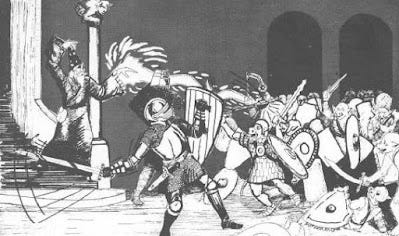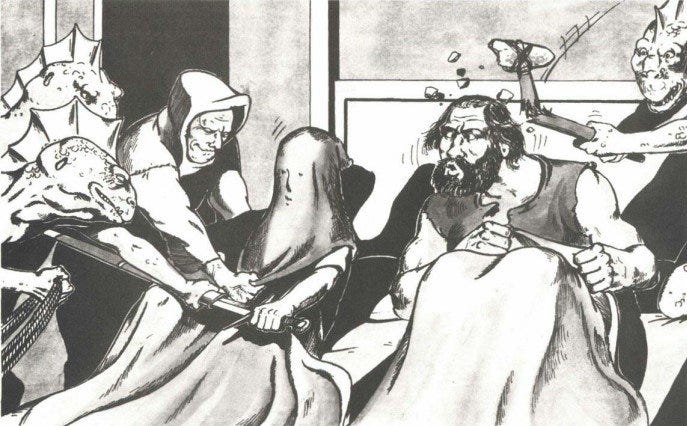Why New Players Struggle with Fiction-First OSR Play
How OSR games are different from other games, and how I changed my GMing style to help my players adapt.
When I started running games in an OSR style, I used Knave to run old-school dungeon crawls. But my friends, whose only ttrpg experience had been years of D&D 5e and a smattering of Dread, didn’t engage with the game the way I expected.
Simply using an OSR ruleset didn’t immediately break my players of all their 5e habits (and it was naive of me to expect it to). They still expected to fight everything and were frustrated when they realized how quickly they died when they engaged with the mechanics of the game.
In retrospect, now I understand how crucial the GM’s role is in shaping player behavior based on how much information they give the players — especially in OSR games, where there is no expectation that 90% of the encounters will be evenly balanced and the player characters’ lives are at stake.
I’m Colin, and I’m a professional video game designer. This is Drolleries, where I write about d&d, ttrpgs, and game design.
A pillar of OSR play is that encounters aren’t meant to be balanced. If the players encounter a really powerful monster, either in a specific room or on a wandering monster roll, they’re meant to think critically about what it would cost them to fight.
The point of this is to encourage players to come up with creative ways to avoid combat, and encourage them to consider retreat as a valid option.
However, in trying to run this style of game with new players, I made the mistake of not giving players enough information. But why was this so deadly?
Mechanics First vs Fiction First
Many new ttrpg players assume that you’re supposed to use the mechanics on your character sheet to engage with the game. They watch other players roll dice and accomplish awesome things, then look down at their sheets and say “can I roll with Presence?” Then, it’s the GM’s job to coax them into… well… roleplaying. “What are you trying to do?”
It’s a natural misconception for new players, because it’s an assumption of all games. In board games, the only way to engage with the game is through the rules. In video games, it’s not possible to do anything that the buttons on the controller don’t let you do. But role-playing doesn’t require rules — ttrpgs are unique in that sense. You can attempt any action, but only some actions have rules to define their outcomes, and it depends on the specific game you’re playing.
I think this is why new players often resort to using their character sheet for everything; they try approaching the game using the mechanics first. And many other ttrpgs work this way. In games like Blades in the Dark and Powered by the Apocalypse, engaging with the mechanics is what creates the fiction. Even if a player doesn’t describe their character’s actions before saying what move or skill they want to roll, the outcome of the move or skill creates an interesting moment that moves the story forward.
But OSR games flip this paradigm, and going against it will get you killed. The mechanics on your character sheet are mostly for combat, but resorting to combat in every scenario will often get you killed. It’s entirely up to the players to create the fiction rather than the mechanics, and that’s why the telegraphing of information is especially important in OSR games.
Randomness Hides the Math
However, the random nature of many of these games obfuscates the underlying math and makes it harder for the players to understand the game and develop heuristics for the impact of their decisions. If the GM rolls 1d12 for damage and gets a 2, the players may not truly understand the danger they’re in. We can take 3 more attacks each, they think.
When I observed this issue, I tried to fix it in the next game I ran by using static damage, such as dealing 3 damage instead of 1d6 — there’s already enough randomness from rolling a d20 to hit and d20 to dodge. And this worked great! But it’s not the only solution.
Information is Power
Players just need more information to base their decision-making on. Once I started being generous with information, my games ran more smoothly.
Now, when my players attack the monster, I tell them how many hit points they have remaining, and when the monster attacks the player, I tell them the damage dice I’m rolling, not just the final result. When my players experience most of the monster’s special abilities, I tell them the monster’s level (or hit dice).
Previously, I thought that just telling my players the monster’s hit points or armor class would break their immersion, that it’d be like the GM crashing through the fourth wall. But now I understand that when weaved into the story, the moment when the GM reveals the monster’s armor class can add to the narrative rather than detract from it.
I also carried this over to 5e, where I tell them the enemies’ AC and exact hit points once they become bloodied (half health). I even tell them my enemies’ saving throw bonus when I make a saving throw. This helps them to act more tactically — if they make the mistake of forcing a Dexterity save from a vampire and see me rolling with +10, they’ll change their strategy.
I even show my players when I roll for wandering monsters. I find that putting a spotlight on the game mechanics, even some GM-facing mechanics, helps players understand the consequences of their own actions and how they affect the game.
I even did away with my DM screen for some games, and I found it drastically changes the dynamic. It had a similar effect to telling the players the target number before they roll in that it made my actions feel more objective.
That’s all! Try giving your players more information and play around with the timing of it.
What I’m Reading
Inspired by Krypto in the Superman movie, Mage Advice talks about the design goals for having a pet in a ttrpg. Playing a character with a pet in a campaign right now, I felt this deeply.
Some of my favorite blogs are nominated for Ennies! Go vote for (and read) Prismatic Weekly, Murkmail, and Playful Void!
I really liked this article by Komodo Games about rolling to see what position the players start the session in, inspired by Blades in the Dark’s engagement roll. I’ve been trying to focus on starting my sessions with a bang, so I might try this one soon.
Not about ttrpgs, but I loved this article by Bangers and Jams about the pressure of the clock in restaurant kitchens, and how much it affects the experience of diners whether they realize it or not.






Thanks for the shout out!
One thing your post made me realize is that I should try sharing more information about enemies with my players. Like you said, it can help them make good decisions about when they should and should not fight.
I'm planning to have a recurring enemy start chasing them soon and I've been worried they'll try to take them on before they're strong enough to do so. Putting everything in the open seems like a good way to prevent that.